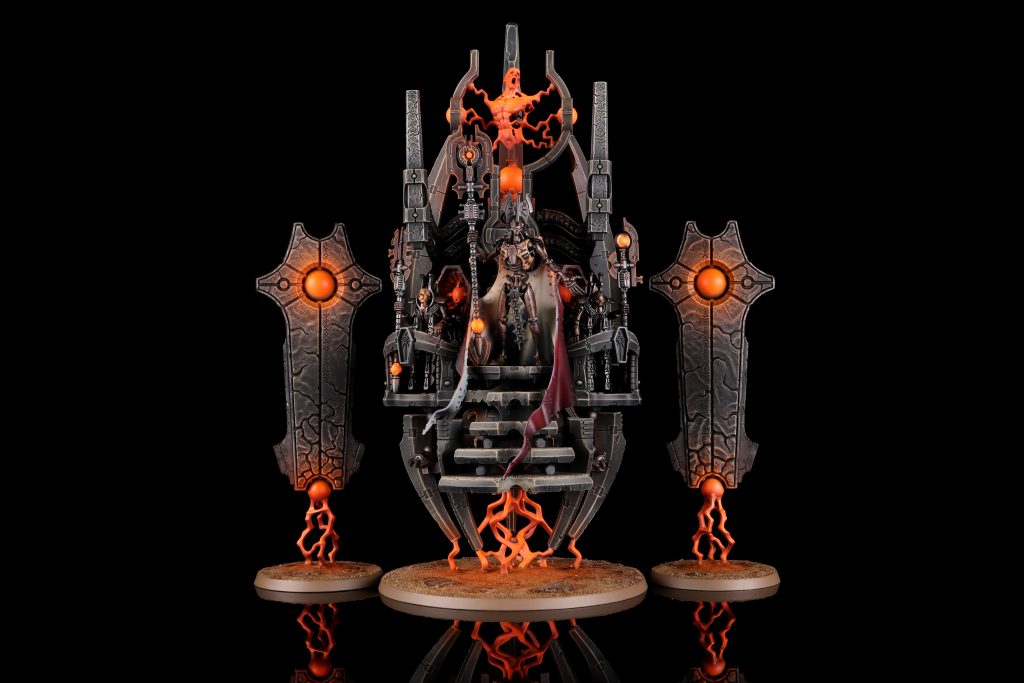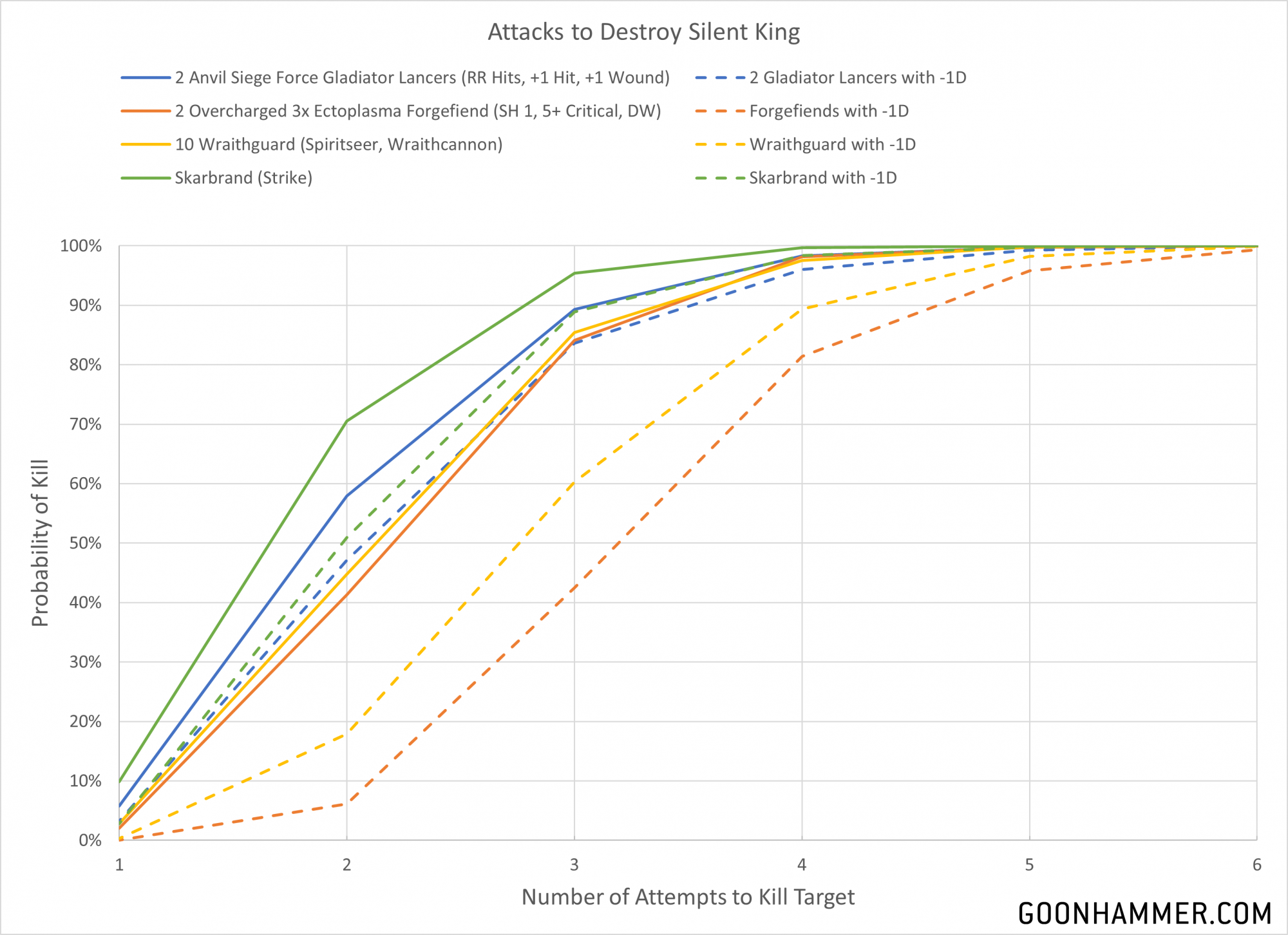This week’s Hammer of Math addresses some specific questions that have popped up from the Goonhammer Brain Trust regarding Necrons.
While the article from last year covered things from a generalist perspective, our resident experts here at Goonhammer have done a deep dive into the book and surfaced with some compelling questions. My job? Run the math and come up with the answers.
Is Entropic Dampening Ever Worth It?
Detachments of the Hypercrypt Legion have access to a 1 CP Wargear Stratagem called Entropic Dampening, which allows you to punish an enemy unit by making their weapons [HAZARDOUS] if they target one of your Titanic units at a range of 18″ or less. The [HAZARDOUS] keyword forces you to roll a Hazardous test for every weapon fired. On a D6 roll of 1 the weapon either kills a model carrying the relevant weapon, or inflicts 3 mortal wounds on Character, Monster or Vehicle.
So is it worth it to use this? Well, the definition of “worth it” is difficult in a subjective game where the opportunity cost of spending a Command Point is challenging to quantify, but at the very least we can use our good friend binomial probability to estimate how much damage can be inflicted. To use the chart below, reference the number of Hazardous tests made on the left hand column and then look across the table to see the probability of how many tests will be failed. The scenario where Entropic Dampening might be worth it is where it has a sizeable chance of inflicting multiple mortal wounds, either by killing Infantry that are shooting multiple weapons or by shaving a few wounds off a vehicle. Sadly the chance of a Repulsor Executioner killing itself by failing all 7 Hazardous tests is only 0.0004%.
 Ultimately the value here goes up the more different guns are being shot by the unit, meaning that “worth it” is going to depend more on the unit shooting than the target it shoots, particularly since this won’t stop you from getting shot. On a Repulsor Executioner where you have seven different guns, the odds are pretty solid you’ll get at least one failed Hazardous test, and 1 CP for 3 mortal wounds is a decent exchange rate in 40k. So if we had to pick a spot where it becomes worth it, the answer is “when you have at least 6-7 guns firing.” Remember that the attacker will have to choose targets and declare what’s shooting before you use this Stratagem.
Ultimately the value here goes up the more different guns are being shot by the unit, meaning that “worth it” is going to depend more on the unit shooting than the target it shoots, particularly since this won’t stop you from getting shot. On a Repulsor Executioner where you have seven different guns, the odds are pretty solid you’ll get at least one failed Hazardous test, and 1 CP for 3 mortal wounds is a decent exchange rate in 40k. So if we had to pick a spot where it becomes worth it, the answer is “when you have at least 6-7 guns firing.” Remember that the attacker will have to choose targets and declare what’s shooting before you use this Stratagem.

What is the expected output of a canoptek doomstalker firing overwatch when it’s in the power matrix?
Canoptek Doomstalkers benefit from the Power Matrix rule of the Canoptek Court Detachment, which allows a unit which is wholly within the Power Matrix to re-roll Hit rolls. When firing using the Fire Overwatch Stratagem, the Canoptek Doomstalker gets D6+1 shots with the [BLAST] trait which hit on a 5+ at S14 and AP -3 for a flat 3 damage. Assuming the gun is not shooting at a large unit, the D6+1 shots average to 4.5 attacks which will hit 55% of the time thanks to the re-roll, meaning an average of 2.5 shots will hit the target. Against a 2+ to wound that translates to an average of 2 wounds, while for a 3+ to wound the average is 1.67. From there the average is reduced by the Save characteristic of the target, which will reduce the average hits from a range of nothing to 50% assuming a 4+ invulnerable save.
This means that the expected value of the Overwatch attack will range from an average of 6.3 wounds dealt against a target of T7 or less with a Save of 4+ or worse, to 2.5 wounds against a target of T13 or less with a 4+ invulnerable. Against a typical tank target you’re looking at an average of 3 to 4 wounds depending on the Save characteristic. That’s not bad for Overwatch, but it’s worth keeping in mind before you opt to spend the CP.

How much of a bastard is the silent king to kill with NANOASSEMBLY PROTOCOLS?
When The Silent King floats around in an Obeisance Phalanx Detachment, he has access to a 1 CP Stratagem called Nanoassembly Protocols which reduces the Damage characteristic of incoming attacks by 1. Given that The Silent King is protected by a grant total of 26 T10 wounds with a 2+/4++ save profile any kind of damage reduction can have a significant impact on efficacy. Things get worse when you take into account the fact that the Triarchal Menhirs have 5 wounds each, meaning that any excess damage beyond what destroys the model is disregarded. Unfortunately my model isn’t able to incorporate that result yet, so the numbers in the chart below are slightly optimistic. I compared roughly equivalent values in terms of Gladiator Lancers in an Anvil Siege Force, Nurgle Forgefiends with 3 Ectoplasma Cannons, a unit of 10 Wraithguard led by a Spiritseer, and Skarbrand.
 Good news for Necron players: The results show a median of between 2 and 3 attempts to kill the target, with Skarbrand having the highest one shot kill probability at 10% (and 3% with Nanoassembly Protocols active). The use of the Stratagem increased the average number of attempts required to kill the target by 9% for the Gladiators, 15% for Skarbrand, 24% for the Wraithguard, and 36% for the Forgefiends. Unsurprisingly, damage reduction is very useful in this situation, but this also means you can play as though you’ll be able to survive some incoming fire from enemy units.
Good news for Necron players: The results show a median of between 2 and 3 attempts to kill the target, with Skarbrand having the highest one shot kill probability at 10% (and 3% with Nanoassembly Protocols active). The use of the Stratagem increased the average number of attempts required to kill the target by 9% for the Gladiators, 15% for Skarbrand, 24% for the Wraithguard, and 36% for the Forgefiends. Unsurprisingly, damage reduction is very useful in this situation, but this also means you can play as though you’ll be able to survive some incoming fire from enemy units.
That said, note that an opponent will often have multiple threats, i.e. two Forgefiends, and so while you’re likely to survive one incoming volley from the game’s heaviest hitters, you don’t want to put yourself in a position to have to survive two or three.
Thanks for reading! If you have any questions or comments feel free to drop us a note in the Comments below or email us at contact@goonhammer.com. That’s also the best way to suggest topics for future articles.



You must be logged in to post a comment.